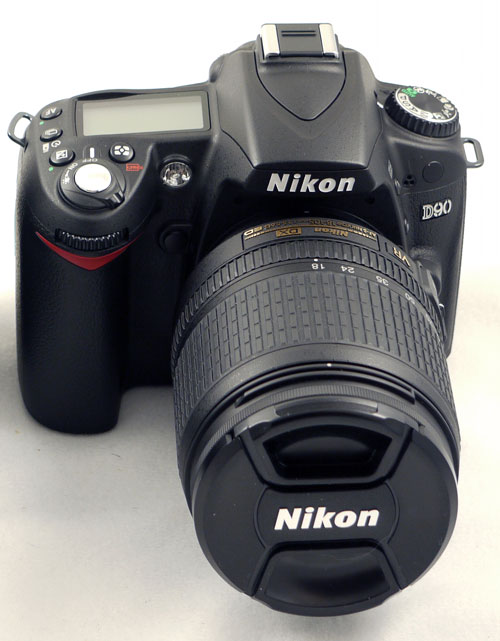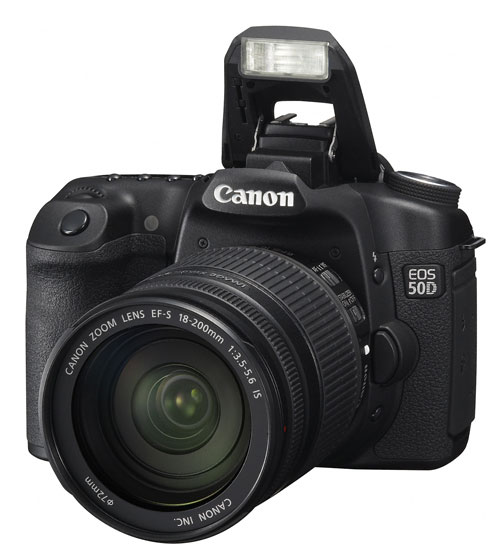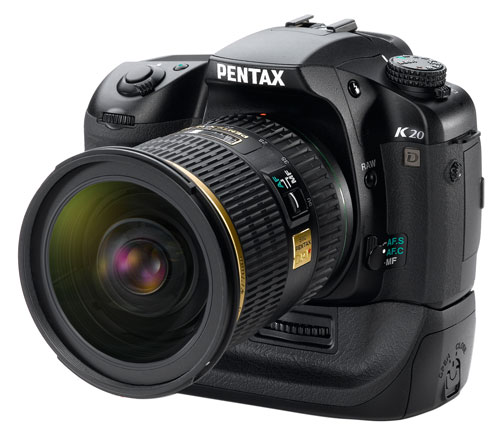Digital Cameras for the Holidays
by Wesley Fink on November 27, 2008 12:00 AM EST- Posted in
- Digital Camera
Prosumer Picks
Photo hobbyists usually have an investment in a particular lens line and that influences their buying decision. It also seems emotions run high among photography hobbyists, so any hard recommendation in the prosumer area invites a stoning from fans of other systems. However, we like to think we are objective and some recent introductions have reshaped value in the prosumer space.

Nikon pulled out all the stops with the new D90. It basically features the same 12.3MP CMOS sensor as the Sony A700 and Nikon D300 with updated image processing. However, the starting price is $999 and not $1395 or $1795. That will deliver a lot of value to the Prosumer segment.
Nikon lavished most of the features of the D300 on the new D90, including the 3" 920,000 pixel hi-res LCD used on the D300 and Sony A700. The only major exception is the 51-point AF module unique to the D300 and A700/D3; the D90 merely has a fast 11-point AF. Also new to the D90 and missing from the D80 are two flavors of Live View and Auto Sensor Cleaning. Image processing has been borrowed almost in total from the D300 with both cameras now featuring Nikon's Scene Recognition System, and D-Lighting for expanded dynamic range. Continuous shooting speed also jumps to 4.5 FPS from the 3 FPS of the D80.
Nikon also introduced a new standard lens with the D90 in the 18-105mm VR AF-S. The new normal zoom is arguably the best image quality of Nikon's current selection of crop-sensor normal lenses. Last, but not least to some buyers, the D90 features a Movie Mode - a first in this class. Unfortunately, auto-focus is not active in the movie mode so this feature was of limited use in our testing. However, it will be a nice option for shooting subjects that stay in place and don't move much - like still life. In total the D90 is a great value in the prosumer class and hard to beat.

The new Canon 50D moves Canon to the top of the class in crop-sensor resolution again with a 15.1MP sensor and an incredibly wide range of ISO adjustments to ISO 12800. However, resolution tests show about the same results as the 12.3MP Nikon D90, D300, and Sony A700. Noise also increases a bit with the more densely packed sensor, resulting in no real gain in noise-reduction at the top, and a slight reduction in dynamic range compared to the competition.
The 50D does feature a 920,000 dot LCD, which is a significant improvement over the 40D 3" low-res screen. Image processing is also sped up with a Digic 4 processor. While the list price is $1395 for body only, the 50D is currently selling for around $1200.

Canon continued the 40D in their product line and the 10.1MP 40D has become a super value in this class. If you want a top advanced amateur camera but price is a concern, you can find the 40D selling for $799 to $849, which is an excellent value.

Another great value in prosumer cameras is the rugged, pro-sealed Pentax K20D, which is now selling in the $750 to $800 price range. Resolution is a very high 14.6 megapixels, but noise and color shifts can become an issue at higher ISOs. AF speed is not the fastest and neither are continuous frame rates, but as a high resolution photo tool with a huge offering of Pentax AF lenses the K20D is an outstanding value.
If you want a more rugged pro Nikon body, 51-point AF, and a few more features - at a higher price - the Nikon D300 is a good choice. The Sony A700 uses the same Sony 12.3MP sensor as the D300, and it is very fast and capable. Sony has been running a $300 off special pricing recently, presumably because a replacement model is expected at PMA early next year. The A700 lacks any kind of Live View if that feature matters to you, but Live View is pretty basic and very slow in most of the DSLR competition so it is more a checklist feature than truly useful.
If you are an Olympus fan, you will need to wait for a couple of months. Olympus has announced the new 12MP E30 that brings most of the great E3 features, including its super fast AF module, down to a lower prosumer price point. The E30 will not ship until early 2009.










41 Comments
View All Comments
Flyboy27 - Friday, November 28, 2008 - link
Nikon D40. Seriously why would I need anything with more MP. Talk about fast and easy to use. Size and weight are very reasonable too. I can turn it on and take a picture before your p/s warms up.Flyboy27 - Friday, November 28, 2008 - link
I would like anandtech to have a serious discussion about magapixels. Why do higher megapixels matter? For web? no! The only way MPs matter is if your printing huge and by huge I mean greater than 20x30. How many times do you need prints that big anyways. Anyone that wants ultimate resolution is going to shoot film anyways. Film can be scanned by a professional lab at higher resolution than any DSLR can take. Just because you have a 20MP camera doesn't mean that you can resolve all those pixels anyways. My point? It is dumb to pay more for more megapixels. Any modern digital camera has enough MPs for any amateur and most pros.WTF is pro-sumer? = amateur photo geek with money. I doubt that pro photographers read this site for advice on cameras. They know what they want already.
All this said (if you want an upgrade from the D40) I think the D90 by Nikon would be a great camera if you want to go that route. It is not worth paying more for any other camera.
I bought a DSLR for the ability to learn to use an SLR camera without having to pay for film. I can learn from my mistakes instantly instead of waiting for film to be developed/scanned. If I already knew how to use an SLR and was comfortable I would be shooting 35mm film and getting it scanned at a much higher resolution than any digital camera.
Wesley Fink - Saturday, November 29, 2008 - link
If readers want to look a little deeper at sensor resolution, sensor size, and noise, take a look at our two part series on the Digital Sensor in The Digital Sensor: A Guide to Understanding Digital Cameras at http://www.anandtech.com/digitalcameras/showdoc.as...">http://www.anandtech.com/digitalcameras/showdoc.as... and The Digital Sensor: Part 2 at http://www.anandtech.com/digitalcameras/showdoc.as...">http://www.anandtech.com/digitalcameras/showdoc.as....Flyboy27 - Saturday, November 29, 2008 - link
Thanks Wesley,I wont go into Digital vs. Film. That is something that a person can only decide for himself. I've already gone into my reasons why I shoot digitally. Besides its all about getting great pictures right? It is my belief that you can get great pictures from most of the cameras out there. Some cameras just make it easier to take more great pictures.
Now my beef with resolution. Just as you have to sit close enough to a 1080p TV at a given size to tell the difference between it and a 720p set the same goes with digital photography. You have to ask yourself "What am I doing with these pictures that I'm going to be taking?" Am I going to make wall size prints? probably not. Am I going to make 20x30" prints? Maybe a few. Am I going to make 5x7s or 12x18s. Definitely. Am I going to use these photos on the web? Most Definitely. These are my answers and yours may be different but based on mine all I'll ever need is 6-10 mp. Fantastic, I don't have to pay extra for more mega pixels just because all the marketing says I do. Marketing tries it's hardest to make you go out an buy more than you need because they have to make money in order to make more cameras and stay in business.
I do take issue with Norman Koren's test. In the test he scanned the film with a $700 scanner. Big deal. He just wiped out any advantage that film might have. He's comparing a digital camera with a scanner, not film. Once again I'm not saying film or digital are better than one another. Pros use both.
I will check out Clark looks interesting and very technical.
I do love anandtech. Quality articles, objective testing. I've recently stopped reading another site due to the slow decline in the quality of their articles/publishing philosophy. Anandtech is now my main source for news and advice on computer hardware. Plus you actually respond intelligently to commentators and most of the commentators comment intelligently as well. Thanks guys.
Wesley Fink - Saturday, November 29, 2008 - link
Can you please provide the source for your information that film has higher resolution than any digital sensor? There are many experts who disagree with you.Norman Koren, the author of Imatest, which is a well-respected Resolution Test Suite, found the resolution of the top films to be equivalent to an 8.3 megapixel full-frame DSLR sensor at http://www.normankoren.com/Tutorials/MTF7.html">http://www.normankoren.com/Tutorials/MTF7.html. Clark at
http://www.clarkvision.com/imagedetail/film.vs.dig...">http://www.clarkvision.com/imagedetail/film.vs.dig... found that Fuji Velvia 100 and 50 were equivalent to a 10 megapixel sensor for intensity detail, and perhaps a 16 megapixel sensor for color detail. All other films he tested, including slide films, were lower in resolution. You can find charts for a wide variety of films at that link.
Clark's final conclusion was 10 to 16 megapixels were the equivalent range of the various film types. Since his work was mostly APS-C sensors it is not really at odds with Koran's tests.
Every other researcher who has tested has generally found 12 to 14 megapixels the equivalent of 35mm film. The larger resolution sensors do show any faults of your lenses and they require the very best glass to resolve those high resolutions.
We did discuss the relevance of megapixels in the article in the discussion of P&S cameras. Our recommendation was that cameras with these tiny sensors - 1/10 to 1/20 the size of an APS-C sensor - have reached the best balance of resolution and noise at around 7 to 9 megapixels. Anything more than this is a waste with these tiny sensors TODAY, but that could change with new sensor technology.
However, in the APS-C sensor the resolution trade-off probably is somewhere around 20 to 25 megapixels with current technology and somewhere around 40 to 50 megapixels in full-frame. Since the sensor is an Analog device that gathers light and converts it to digital info the physical size of the pixel is the most important specification for judging ISO range and noise.
Prosumer is a designation used by almost every camera review site. It is the same as Advanced Amateur. It basically means a class of cameras geared to the hobbyist or advanced amateur that is also used by some Pros. The lines have become particularly blurred as sealing has improved in this class and technical advances have accelerated in digital imaging.
computerfarmer - Friday, November 28, 2008 - link
Nikon D40 is a good camera with 6mp. Then there is the Nikon D40x with 10mp. Both have 23.7 x 15.6 mm CCD sensors. The D40x has ISO 100 and the D40 does not, it starts at ISO 200. The D60 has very little on the D40x and in some cases the D40x is better.You are correct in the fact the D40 will do the job and very well at that.
Nehemoth - Friday, November 28, 2008 - link
I would like to get one new camera bellow the 200US mark, but I don't like the cannon design and I would like that only use 2 AA batteries (so some fujifilm are out), also I like the aesthetics of those old cameras, like DSLR design.Any recomendation?.
computerfarmer - Friday, November 28, 2008 - link
The FujiFilm FinePix S700 has the DSLR look and is selling for 179CDN. It uses 4 AA batteries and has a 10x zoom. you can read user comments herehttp://www.dpreview.com/reviews/read_opinions.asp?...">http://www.dpreview.com/reviews/read_opinions.asp?...
Good luck
Nehemoth - Friday, November 28, 2008 - link
That's what I said before, I don't want fujitsu cause use 4 batteries, I would like of just 2 batteries.ubiloo - Friday, November 28, 2008 - link
I've been shooting since more than 20 years, I've used a lot of cameras from Canon, Nikon and Pentax.Even though the Pentax lacks a full-frame camera (shame! shame!), I'm deeply convinced of the fact that some current models really are among the best for the price. Why is Pentax so often absent from parades?
In particular, I think that the K200D is terrifying for its street price (I don't know about the K-m); I've now been using it for some time and it's a real solid camera with good, sometimes very good, picture quality. I bought it for at least €100 than any comparable camera. This particular model also deletes one of the drawbacks of previous models: with its kit lens, the auto-focus speed is really convincing, try to believe!
As for lenses, both Sigma and Tamron are available, so whenever Pentax is weak, they deliver...